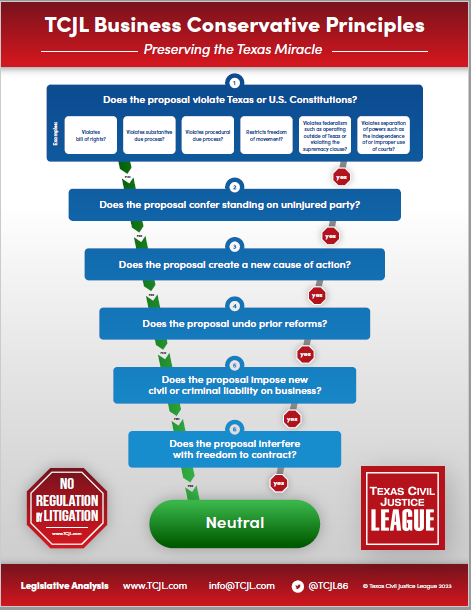
Justice Jeff Boyd

Justice Evan Young
Given how rarely the Texas Supreme Court grants motions for rehearing, its decision last December to reopen a wrongful death case struck us as very significant. As things turned out, it was—in more ways than one.
The case, Angela Horton and Kevin Houser v. The Kansas City Southern Railway Company (No. 21-0769; June 28, 2023), arose from a collision between a vehicle driven by plaintiffs’ mother and a Kansas City Southern train. Plaintiffs alleged that KCS’s negligence proximately caused the accident based on KCS’s creation of a “humped crossing” by building up the level of the crossing over many decades of maintenance and on the fact that the yield signs posted on the cross-buck signs were missing at the time of the accident. The trial court submitted a broad-form negligence question to the jury. KCS objected, asserting that the negligence question should be bifurcated into two questions, one on the humped crossing and the other on the yield signs. The trial court denied the motion. The jury found both the decedent and KCS 50% responsible. The trial court awarded $200,000 to plaintiffs. KCS appealed to the Dallas Court of Appeals, which, over a dissent reversed, holding that federal law preempted plaintiffs’ claims. Plaintiffs sought review.
In an opinion delivered on June 30, 2023 and authored by Justice Boyd, SCOTX reversed the court of appeals’ holding that federal law preempted plaintiffs’ claims because “KCS did not meet its burden to establish that [plaintiffs’] negligence claim complaining of the humped crossing would pose the ‘unreasonable burden or interference with rail transportation’ required to trigger implied preemption under [federal law].” The Court, however, remanded the case to the district court for a new trial because the trial court’s broad-form question on negligence violated the Casteel rule. The rule, derived from Crown Life Insurance Company v. Casteel, 22 S.W.3d 378 (Tex. 2000), held that a jury instruction that includes two theories of liability is harmful error if the court cannot determine whether the jury found negligence on a valid or invalid theory. Determining that plaintiffs did not present sufficient evidence that the missing yield signs proximately caused the accident, SCOTX concluded that Casteel applied because the trial court could not determine whether the jury’s finding of negligence was based on the yield sign theory or the humped crossing theory.
Both parties moved for rehearing, KCS on the preemption issue and plaintiffs on the Casteel issue. The Court denied KCS’s motion, but granted plaintiffs’ motion and invited further briefing on Casteel. In a new opinion, likewise authored by Justice Boyd, the Court reaffirmed its earlier holding regarding preemption, but changed its mind on Casteel. This volte face provoked what we might characterize as a “furious” dissent from Justice Young (to the extent we can apply that term to such a calm and collected jurist as he is!), joined by Justice Blacklock, turning a unanimous decision into a partially splintered one. The majority opinion’s discussion of implied preemption further prompted Justice Busby, joined by Justices Devine, Blacklock, and Young, to pen a concurring opinion imploring the United States Supreme Court to reconsider its implied preemption jurisdiction along lines suggested by Justice Thomas. Thus, what presented initially as a fairly “routine” case (to use Justice Young’s language) has ended up taking on substantially enlarged constitutional dimensions implicating the sanctity of a jury verdict and federal separation of powers doctrine. And along the way, the new opinion withdrew the original’s remand for new trial and substituted an affirmance of the trial court’s judgment on the verdict for the plaintiff.
As noted above, the Court unanimously agreed that KCS failed to show that federal law, specifically 49 U.S.C. 10501(b) (part of the 1995 ICC Termination Act), either expressly or implicitly preempted state common law negligence. Both the majority and concurring opinions go into exhaustive detail on this issue, and we commend those parts of the opinion for a complete current law snapshot for where federal and Texas authority stand. As to express preemption, Justice Boyd focused on a close reading of the pertinent federal statutes to reach the conclusion that § 10501(b) does not preempt Horton’s common law negligence. Though “[i]t may be, as other courts have held, that a common-law claim could so directly seek to control, manage, or govern the core operational functions of a rail carrier that it could be said to seek a ‘remedy with respect to regulation of rail transportation’ . . . negligence claims based on railroad-crossing safety will rarely meet that standard.”
Turning to the more nuanced question of implied preemption, Justice Boyd begins with the legal proposition that “a federal law may impliedly preempt state law if Congress intended federal law to occupy the field exclusively or if the state is in actual conflict with and creates an obstacle for the federal law” (citing Cipollone v. Liggett Grp., Inc., 505 U.S. 504 (1992)). This “implied obstacle preemption” doctrine, as Justice Busby points out in his concurring opinion, is controversial, especially in conservative legal circles, because it involves the courts in speculation over Congress’s “intention” in a potentially unconstitutional way. Justice Boyd skinned the cat by pointing to KCS’s weak evidence that having to defend (and pay) a judgment in this case would establish “an unreasonable burden or interference with rail transportation (there was conflicting evidence indicating that lowering the track to smooth out the humped crossing could be relatively inexpensive and accomplished without shutting down the line for a couple of days). Justice Busby took no issue with this analysis but wrote a 45-page opinion urging SCOTUS to revisit its implied obstacle preemption cases and adopt Justice Thomas’s proposed test “that asks whether state law stands in ‘logical contradiction’ to federal law” (citing Merck Sharp & Dohme Corp. v. Albrecht, 587 U.W. 299, 319 (2019) (Thomas, J., concurring)). If this test applied in this case, it is extremely doubtful that the issue would ever have gotten to SCOTX, since we can’t think of any scenario in which a common law negligence claim under state law would “logically contradict” a statute governing operations of interstate railways unless the federal statute said it did.
Having reaffirmed its earlier holding that there was no federal preemption, Justice Boyd turned to the issue for which the Court granted rehearing: the application of the Casteel rule. To reset the issue, the trial court submitted one broad-form instruction on negligence. Plaintiff asserted and presented evidence supporting alternative theories on which a jury could find negligence: the humped crossing or the missing yield sign. When KS requested an additional jury instruction specifying each theory, the trial court, agreeing with Plaintiff, refused. That’s what created the Casteel problem, which simply describes the way reviewing courts apply Texas Rules of Appellate Procedure 44.1 (court of appeals review) and 61.1 (SCOTX review). Those rules hold that “a trial court’s error is harmful if it either (1) probably caused the rendition of an improper judgment or (2) probably prevented the appealing party from properly presenting the case to the court of appeals.” To make this determination, the reviewing court must review the entire record. Here KCS argued that it was impossible to tell whether the jury’s answer to the negligence charge was based on the humped crossing or the missing yield sign, which, as the Court indicated in Casteel and its progency, constituted presumptive harmful error. Indeed, that’s exactly what the Court held the first time.
So what changed? First, the majority reiterated that “trial courts [] submit issues to juries using broad-form questions ‘whenever feasible,’” as instructed by Texas Rule of Civil Procedure 277. Rule 277 isn’t “absolute,” and, as in Casteel, sometimes it is not feasible to use broad-form submission. If a jury verdict might be based a theory that is “invalid,” Casteel held that “the error is harmful and a new trial is required if an appellate court ‘cannot determine whether the jury based its verdict on an improperly submitted invalid theory.’” The question then becomes how the appellate court makes such a determination, which is where the “presumption of harm” comes in to the picture. Once the appellant points out the existence of the invalid theory, the burden shifts to the appellee to demonstrate, based on the entire record, that “the alleged error does not probably prevent the appellant from presenting the appeal.” KCS argued that it was prevented from presenting the appeal because it couldn’t know whether the jury based its verdict on a “valid” or “invalid theory.” According to KCS, the invalid theory involved the humped crossing (which it argued, and the court of appeals agreed, was preempted), which at trial Plaintiff emphasized more heavily than the missing yield sign theory. In the first go around at SCOTX, as we have seen, the Court determined that the humped crossing theory was valid (not preempted) but that there was no legally sufficient evidence to support the jury’s verdict if it was based on the missing yield sign. Casteel thus dictated that the error was harmful and that a new trial was the only way to sort it out.
What changed is that the majority decided that an argument about invalidity that stemmed from the sufficiency of the evidence was “less likely” to be harmful than one based on legal invalidity. Having made this distinction, the majority proceeded to consider Horton’s rebuttal of the Casteel presumption and concluded that the jury “probably” based its negligence finding on the humped crossing claim, not the missing yield sign claim, which the majority found not to be supported by legally sufficient evidence (i.e., no evidence of proximate cause). This is where Justice Young thought the majority went way off the rails: “To dilute Casteel, the Court latches onto the casual use of the English word ‘presumption’ in a few of Casteel’s progeny and now proclaims that Casteel no longer stands for. The Court compounds this missetep by saying that an error is not even ‘presumptively’ harmful if the commingling error includes a theory where the evidence was legally insufficient (i.e., as opposed to a theory that for some other legal reason was invalid).”
He goes on. “It makes no sense, either, because what threatens the jury-trial right is a judgment that relies on something a jury did not find. Whatever label one gives that ‘something’ is of no importance. What matters is not the reason for the invalidity but the risk that the jury relied on a theory (any theory) that is legally invalid. Comingling any legally invalid theory within a broad-form question means that we cannot know if the jury did or did not rely on it.” That’s a lot of italicized words (and there are a lot more sprinkled throughout the opinion) and some pretty blunt language. Whether one agrees with Justice Young or not, it does seem that understanding Casteel’s application hasn’t gotten any easier. One might reasonably ask whether we even need Casteel, if a reviewing court is simply going to review the entire record in an effort to determine what the jury “probably” and why it did it. Since the rules already require that review anyway, the Casteel presumption, together with its newly-minted distinction between “legally valid” theories and those for which the evidence may not be “legally sufficient,” seems likely to involve reviewing courts in trying to, as Justice Young put it, “presum[e] the grounds on which a jury ruled.”











